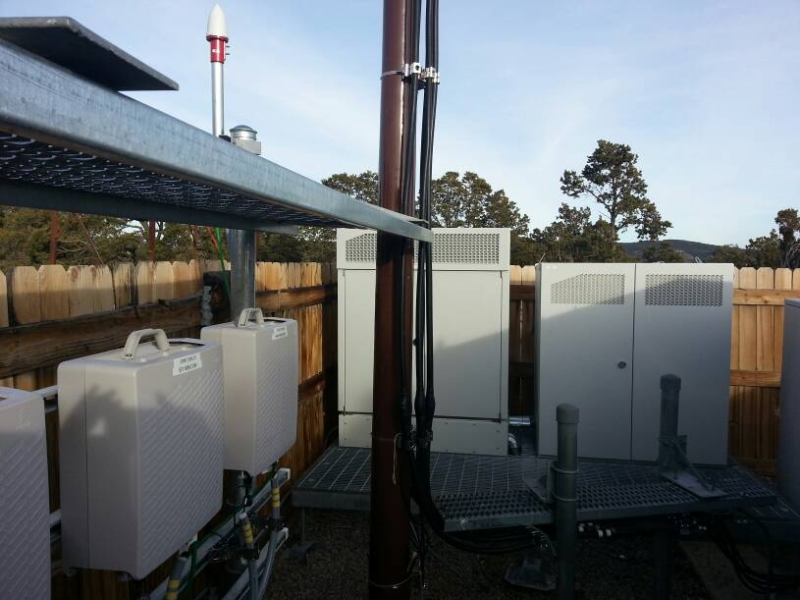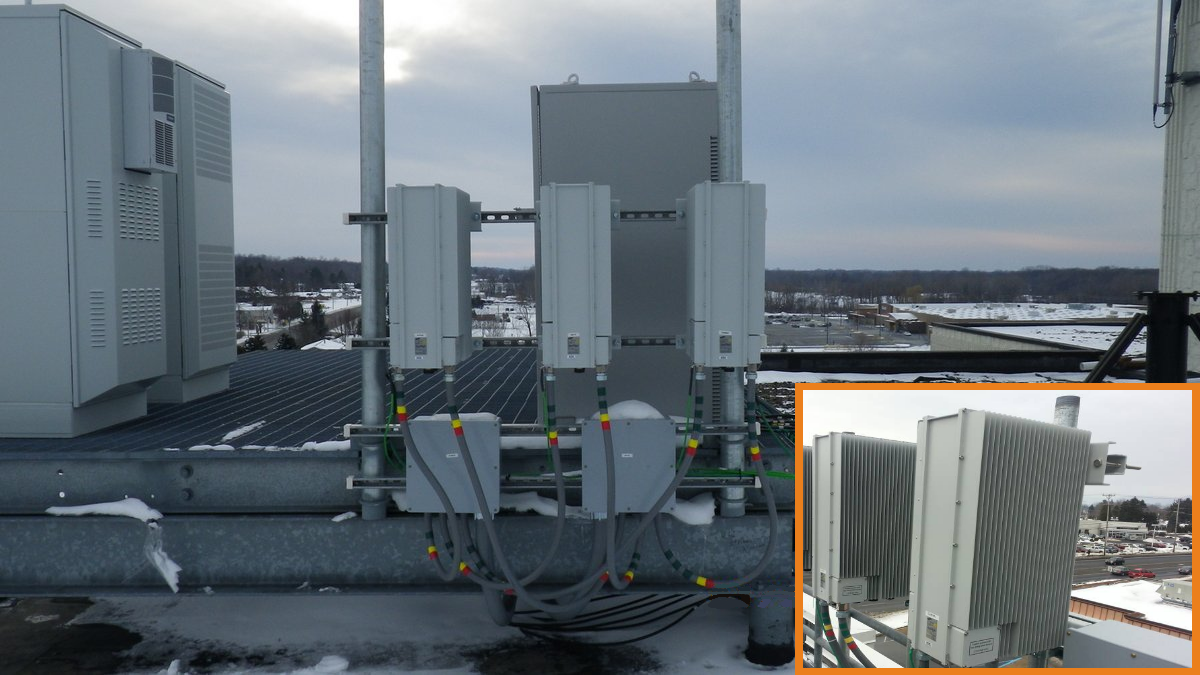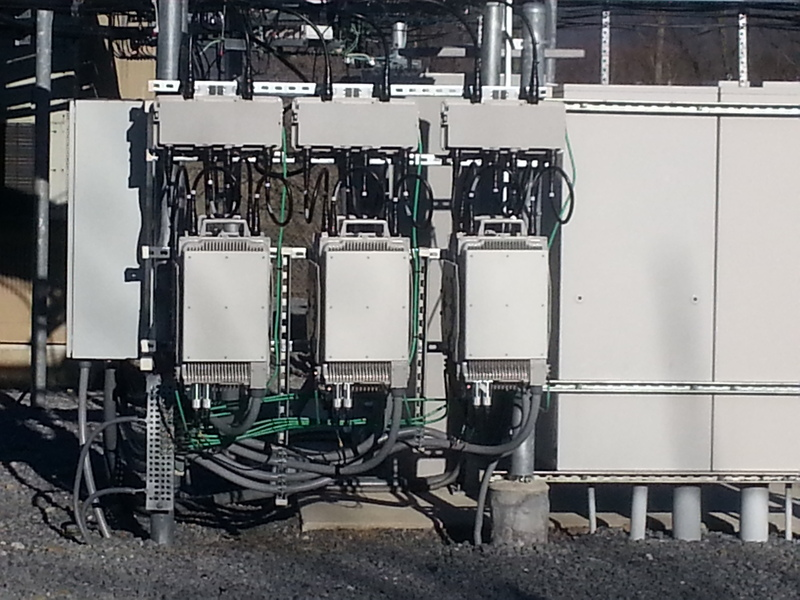Sprint deploys special Ground Mount Option Network Vision sites in some low capacity and high engineering locations
by Robert Herron
Sprint 4G Rollout Updates
Wednesday, February 13, 2013 - 1:13 AM MST
Often you may see us refer to a GMO site around S4GRU. But, what is a GMO site? GMO stands for Ground Mount Option. Or sometimes, it will be referred to as a GMR (Ground Mount RRU) site. In this article we will explain many points about the Ground Mount Option.
In the most basic explanation, a Ground Mount site is one where they are doing a partial Network Vision conversion instead of a full build conversion. A full build site is one where they upgrade all the hardware at a site, including the base station equipment (RBS/MBS), install new multi-mode antenna panels on the tower, add Remote Radio Units (RRU’s, sometimes also called RRH’s), and run new fiber optic lines from the base station equipment up to the RRU’s on the tower. These are the ones most people who follow along Network Vision deployment are familiar with.
However, a GMO site will install new base station equipment, with the RRU’s mounted down at the Ground Level, near the new base station cabinets. Then the existing lines running up the tower and the existing panels are reused. These are not to be confused with full build sites with Ground Mounted RRU’s. Those are not Ground Mount Option sites, because they still offer full Network Vision panels, and complete 800MHz and LTE services (where possible). They just are required to mount the RRU’s away from the panels for logistical reasons.
How did Sprint determine which sites were to receive the Ground Mount Option instead of a full Network Vision rebuild?
I have had the privilege of talking with several Sprint and OEM employees about the Ground Mount Option the past few weeks. Every one of the 38,000+ Sprint sites in the country had a site survey visit in 2011 to establish logistics and planning for the Network Vision upgrade. Each site is broken down to three priorities, largely based on the traffic and carrier count. See the priorities below:
- High Priority...site gets full Network Vision upgrade. If site cannot support RRU's and new panels, engineering is done and structure modifications will be made and the site is fully upgraded.
- Moderate Priority...site gets full Network Vision upgrade. If the site requires minor modifications to support RRU's and NV panels, then it gets fully upgraded. If it requires major attention with full engineering, then a ground mount solution is implemented.
- Low Priority...low priority sites only get a full NV upgrade with new NV panels and tower mounted RRU's if no structural modification is necessary. If anything is required at a low priority site, the Ground Mount Option is deployed. Also, some low capacity/low priority sites get GMO installs, no matter if the site can support a full install now.
At the site survey time back in 2011, each survey team made a judgment call based on their review of the site whether to go full build or GMO, taking into account the priority. And there are anomalies that just do not make any sense. Some markets have no GMO sites at all. And some markets have all GMO sites, like Western Pennsylvania. Also, some site owners will not allow NV full build for various reasons. In these instances, a Ground Mount Option was selected.
What are the advantages of a Ground Mount site?
The biggest advantage of a GMO site is these sites are being worked on now and getting Network Vision benefits in the middle of the NV program, instead of at the end of the build out. Many 3rd Round Markets have started earlier because of GMO conversions. 1st and 2nd round markets have mostly full build sites with only a few GMO’s, or none at all. This allows some love for customers that would have been pushed off to the very end of Network Vision to see some improvements now.
GMO sites are much faster to deploy with no tower work required. Most GMO sites will require minimal permitting from local authorities, or often no permitting at all. Also, GMO's require less negotiation with the site owner, as it does not materially change the site. GMO site conversions are already under way all around the country, and all of them should be completed before the end of this Summer. There are already 100’s of them with 3G upgrades in place.
Ground Mount Option sites also will bring LTE much sooner at many locations. Because LTE 1900 can be run on most GMO sites if the appropriate backhaul is available and Sprint has the OEM install the appropriate number of RRU’s or RRU type. The first LTE capable GMO’s are coming online now. Alcatel Lucent has two live, one in New Bern, North Carolina and another one in the Shentel market in South Central Pennsylvania. Samsung has one live in Dayton, Minnesota. This is just the beginning.
What are the cons of a Ground Mount Option site?
There are a few. The first con with the Ground Mount Option, is there will not be any 800MHz service deployed. Sprint is in the process of adding CDMA 800 voice service to full build Network Vision sites. Sprint will also begin deploying LTE 800 service to full build NV sites before the end of 2013. However, GMO sites cannot support 800MHz service, as the existing tower mounted panels do not support 800MHz. In some rural areas, this is a big disappointment as customers have been waiting for 800 MHz signal propagation benefits in the boonies (like me).
The second issue, is the availability of LTE. All full build sites get LTE, but some GMO sites will not be getting LTE deployments. Most GMO sites can support LTE through existing panels, so long as there are not too many CDMA carriers installed. However, some higher capacity GMO sites will not get LTE. Also, some of the most backhaul challenged sites in the Sprint network are GMO sites. They will not get LTE initially because Sprint is unable to get sufficient backhaul to the site to support LTE performance requirements, or in some instances Sprint does not want to go through the difficulty of equipping some sites that are a low priority.
The last negative detriment of a GMO site is signal propagation benefits of panel mounted RRU’s. A Network Vision full build site with panel mounted RRU’s can achieve up to a 20% signal gain at 1900MHz. However, the full 20% is only realized at very tall boomer sites with little downtilt. Most sites get more like a 5% signal increase. And these GMO’s will not get that extra signal benefit.
Are Ground Mount Options this way forever?
Furthermore, at sites where the GMO is implemented, supposedly they will come back at the end of NV and do the engineering and structural modifications. At that time 800 service will be added when the new panels are installed, as well as LTE to sites that can secure appropriate backhaul.
I have heard that in some instances (maybe a few hundred), they are using GMO's where they could not come to an agreement with the site owner. Whether financial agreement or logistical/structural. In those instances, Sprint is identifying other adjacent sites that they may move the site to at the end of NV. If no other options can be achieved, it may permanently stay a GMO and never have NV panels and 800 service.
My understanding has grown tenfold in the past 2 weeks between talking to the Ericsson tech that's been on site and a long conversation I had with an OEM deployment manager. The most recent conversation I had, the source said they recently heard that more funding is being identified that could go ahead and do more work with GMO sites. Which may include converting them to full builds earlier, or at least changing out legacy panels to NV panels to add support for 800MHz.
Differences between vendors
Not all GMO sites are the same. Sprint is using three different vendors to deploy Network Vision. Ericsson, Samsung and Alcatel Lucent. Each of these three OEM’s have their own proprietary equipment. Different base station equipment and different RRU’s.
Samsung has two types of RRU’s. 800MHz and 1900 MHz RRU’s. Each of the two Samsung RRU types can do both CDMA and LTE from the same unit, supporting up to four carriers each. At a Samsung GMO site, only one RRU is needed per sector, as the RRU can do LTE and CDMA on the same unit.
However, Ericsson and Alcatel Lucent do not have it so easy. These two OEM’s cannot run CDMA and LTE on the same RRU. They need a separate RRU for CDMA and LTE on each sector. This is more work and more cost.
S4GRU has been told that Ericsson is finalizing a new RRU that can handle CDMA and LTE on the same unit, but they are not in production yet. These are referred to around the forums as RRUS12. Many Ericsson GMO sites have been spotted with only a single RRU per sector. Unfortunately, these have all been RRUS11 units, which cannot support CDMA and LTE together, only in separate RRU’s. Hopefully many of these will get a second RRU still to support LTE, or maybe be switched out with an RRUS12 unit when they start to hit the streets.
In closing
Some of our members have been quite disappointed to learn that their site was selected for a Ground Mount Option. And I have to admit, I too initially was disappointed myself. Especially since my site is one of the GMO’s that will not receive LTE. At least, at first. ![]()
The thing that we have to keep in mind is these are sites that are either very low priority or very difficult to upgrade. These were always going to be the very last sites to be touched at all, if at all. The majority of GMO sites probably wouldn’t have started until Spring/Summer 2014.
For these sites to receive partial upgrades now is a very good thing. Many of us want everything, and we want it yesterday too. This is not practical though. All things considered, the Ground Mount Option is an elegant solution to the problem. Sprint just needs to push the envelope and install LTE on every one where it is physically possible.
Oh and Dan, please add LTE to my GMO site (EP03AL506). It just will take two more RRUS11 units, or possibly a prototype RRUS12 unit. Just imagine the good S4GRU publicity you’d get. I will even arrange the backhaul for you! ![]()

Ericsson GMO site photo. New Ericsson NV base cabinets in the back and ground mount RRU's on the left. Three CDMA RRU's present here, one for each sector. No LTE at this site initially.

Samsung GMO site photo. New Samsung NV base cabinets at the left and ground mount RRU's directly in front. Three RRU's present here, one for each sector. Samsung GMO sites can run CDMA and LTE if set up that way.

Alcatel Lucent GMO site photo. New AlcaLu NV base cabinets on the right and ground mount RRU's on the center. Six CDMA RRU's present here, two for each sector (one behind each also). AlcaLu GMO LTE sites will require two RRU's per sector.
-
 27
27









46 Comments
Recommended Comments